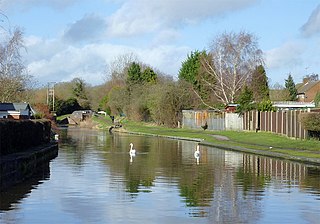
Dudley is a market town in the West Midlands, England, 6 miles (9.7 km) southeast of Wolverhampton and 8 miles (13 km) northwest of Birmingham. Historically part of Worcestershire, the town is the administrative centre of the Metropolitan Borough of Dudley. In the 2011 census, it had a population of 79,379. The Metropolitan Borough, which includes the towns of Stourbridge and Halesowen, had a population of 312,900. In 2014, the borough council adopted a slogan describing Dudley as the capital of the Black Country, a title by which it had long been informally known.

Smethwick is an industrial town in Sandwell, West Midlands, England. It lies 4 miles (6 km) west of Birmingham city centre. Historically it was in Staffordshire and then Worcestershire before being placed into then West Midlands county.

Stourbridge is a market town in the Metropolitan Borough of Dudley in the West Midlands, England, situated on the River Stour. Historically in Worcestershire, it was the centre of British glass making during the Industrial Revolution. The 2011 UK census recorded the town's population as 63,298.

The Metropolitan Borough of Dudley is a metropolitan borough of West Midlands, England. It was created in 1974 following the Local Government Act 1972, through a merger of the existing Dudley County Borough with the municipal boroughs of Stourbridge and Halesowen.

Brierley Hill is a town and electoral ward in the Metropolitan Borough of Dudley, West Midlands, England, 3 miles (4.8 km) south of Dudley and 1 mile (1.6 km) north of Stourbridge. Part of the Black Country and in a heavily industrialised area, it has a population of 13,935 at the 2011 census. It is best known for glass and steel manufacturing, although the industry has declined considerably since the 1970s. One of the largest factories in the area was the Round Oak Steelworks, which closed down and was redeveloped in the 1980s to become the Merry Hill Shopping Centre. Brierley Hill was originally in Staffordshire.

Kingswinford is a town of the Metropolitan Borough of Dudley in the English West Midlands, situated 5 miles (8.0 km) west-southwest of central Dudley. In 2011 the area had a population of 25,191, down from 25,808 at the 2001 Census.

Ashwood is a small area of Staffordshire, England.

Amblecote is an affluent urban village in the Metropolitan Borough of Dudley in the West Midlands, England. It lies immediately north of the historic town of Stourbridge on the southwestern edge of the West Midlands conurbation. Historically, Amblecote was in the parish of Oldswinford, but unlike the rest of the parish it was in Staffordshire, and as such was administered separately.

Dudley South is a constituency represented in the House of Commons of the UK Parliament since 2015 by Mike Wood of the Conservative Party.
Wollaston is a village on the outskirts of Stourbridge in the English West Midlands. It is located in the south of the Dudley Metropolitan Borough, one mile west of Stourbridge town centre.

The Stourbridge Canal is a canal in the West Midlands of England. It links the Staffordshire and Worcestershire Canal with the Dudley Canal, and hence, via the Birmingham Canal Navigations, to Birmingham and the Black Country.
Oldswinford or Old Swinford is an area south of the centre of Stourbridge, West Midlands, England, which takes its name from a civil parish abolished in 1866.

The Red House Cone is a glass cone located in Wordsley in the West Midlands, adjacent to the Stourbridge Canal bridge on the A491 High Street. It is a 90-foot (27 m) high conical brick structure with a diameter of 60 feet (18 m), used for the production of glass. It was used by the Stuart Crystal firm till 1936, when the company moved to a new facility at Vine Street. It is one of only four complete cones remaining in the United Kingdom.
Wall Heath is a suburban village in the Dudley Metropolitan Borough in the West Midlands of England. It is located on the A449 road, approximately 1.5 miles northwest of Kingswinford, 5 miles west of Dudley Town Centre and 9 miles north of Kidderminster. It forms part of the West Midlands-South Staffordshire border.

Russells Hall Hospital is an NHS general hospital located in Dudley, West Midlands, England, managed by the Dudley Group NHS Foundation Trust. The hospital is south-west of the town centre on the A4101 road, which connects to the Kingswinford area of the borough.

Old Hill is a village in the metropolitan borough of Sandwell, West Midlands, England, situated around 2 miles (3.2 km) north of Halesowen and 3 miles (4.8 km) south of Dudley. It is part of the West Midlands conurbation.

Swindon is a village and civil parish located in the district of South Staffordshire, in the county of Staffordshire, England. It is 6 miles (6 km) west of Dudley, 2 miles (6 km) northwest of Kingswinford and 2 miles (6 km) southwest of Wombourne. Swindon is located just outside the county and conurbation of the West Midlands. It borders the metropolitan boroughs of Dudley and Wolverhampton to the east and northwest. The parish which includes Swindon and the neighbouring villages of Hinksford and Smestow had a population of 1,279 recorded in the 2021 Census.

Broadfield House, a Grade II listed building, was home to a glass museum and hot glass studio, owned and operated by Dudley Council museum service and was located in Kingswinford, West Midlands, England. The museum closed on 30 September 2015.
Summerhill School is a mixed community secondary school located in Kingswinford, West Midlands, England.
















